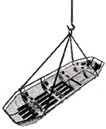 J
JIn the event of an accident, the team has set procedures and a preplanned objective to get victims to the surface in time for local emergency responders to take over, usually within 15 minutes or less. "Time is critical," says McHugh.
 |
| Long Reach. Incident commanders like to lean on construction machines, when appropriate. (Photo courtesy of Brandenburg Industrial Service Co.) |
Professional rescuers judge their performance by what they call the "Golden Hour," the longest amount of time that should pass between trauma and treatment. Rescuers say that patients who make it to a hospital in time have a better chance of surviving a life-threatening injury than those who take longer. As the clock ticks away, untreated trauma becomes more difficult to control.
Tunneling contractors like Jay Dee/Affholder must deliver accident victims to the surface before they can be treated by medics. Drop shafts are few and far between and local rescuers wont venture down into the unfamiliar caverns.
But when a construction accident puts a worker in danger, the human instinct to act quickly is not always enough to save a life. Having the right tools and equipment at hand, and knowing how to use them, is just as important. A rescue can turn into another crisis if ill-equipped workers get caught up in emotional confusion and "dont want to leave their buddy," says Jay Reardon, fire chief for the Village of Northbrook, Ill.
First-Aid Kits and Air Packs
Subject to certain mine safety laws, tunneling crews carry typical $200 industrial first-aid kits and $800 portable one-hour air packs, as well as specialized gear, such as immobilizing backboards, biomarine packs and "stokes" baskets, also called rescue sleds. Made of lightweight plastic or steel and costing between $200 and $500, the baskets cradle victims as they ride their way up drop shafts to meet the ambulance at the top.
Fortunately, no one on McHughs team has had to take that ride. But last year, a mechanic who had a heart attack fell to the ground and suffered minor head trauma. Nearby workers "had his head bandaged and put a cervical collar on him by the time we got there," says Joe Eaker, technical rescue coordinator for the South Holland Fire Dept. The patient survived and is back at work, thanks to advance planning with fire officials about jobsite locations, who to call and where to meet up, McHugh notes.
Stokes baskets are useful for extricating workers from various scenarios, including high-angle accidents, trench cave-ins and building collapses. Using them requires rigging gear and a hoisting device. Smaller fire departments may not have the resources to buy them. Aerial ladder trucks, which typically cannot lift more than 500 lb, have even less capacity at a longer reach and start out at around $500,000.
On top of that, experts say that calling 911 doesnt always guarantee the same local responder is on the line every time. Project managers should meet up with...
oseph A. McHugh is the type of construction safety manager who hopes for the best, but plans for the worst. His job on a $169-million, high-risk tunneling project for joint venture general contractor Jay Dee/Affholder, South Holland, Ill., is guarding the safety of about 80 underground workers finishing out an eight-mile-long wastewater tunnel beneath south suburban Chicago.
Post a comment to this article
Report Abusive Comment